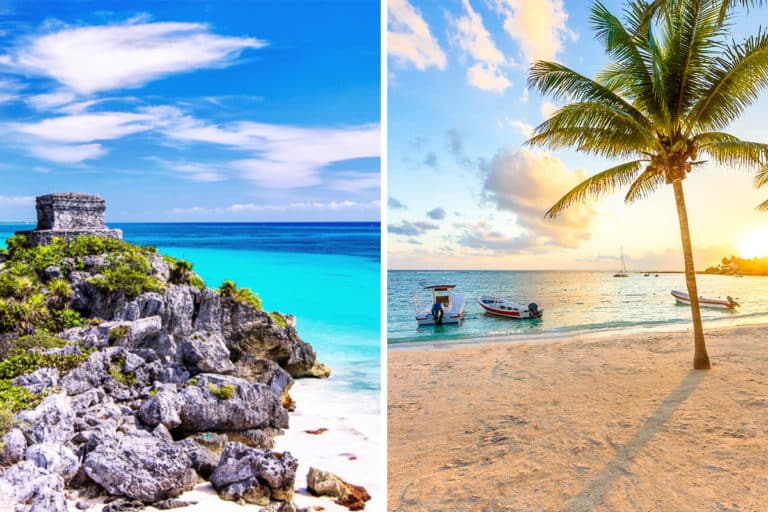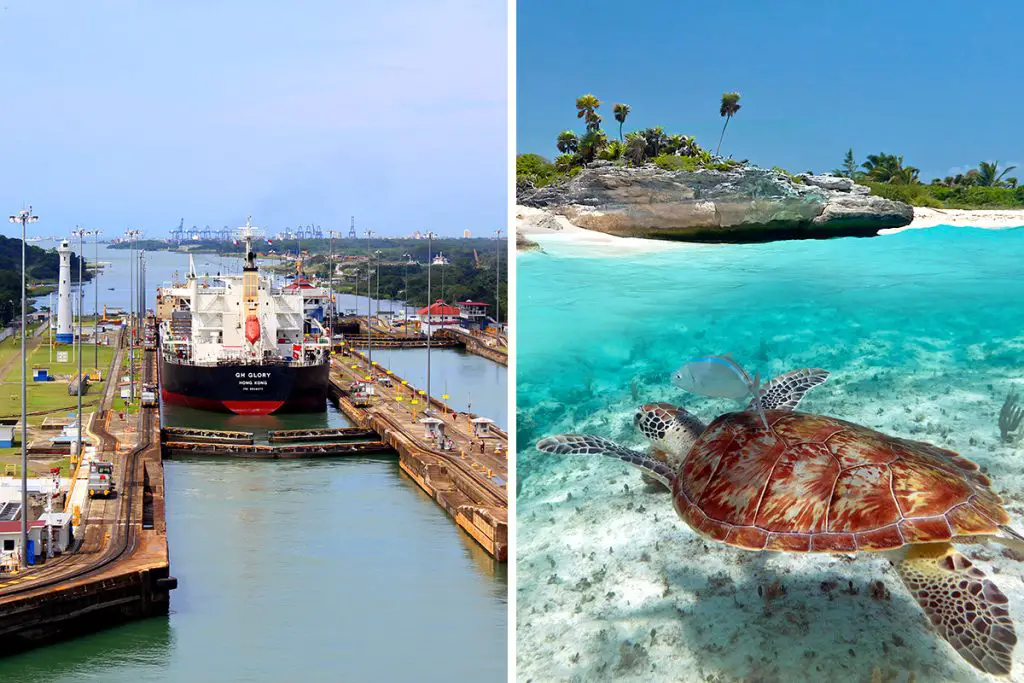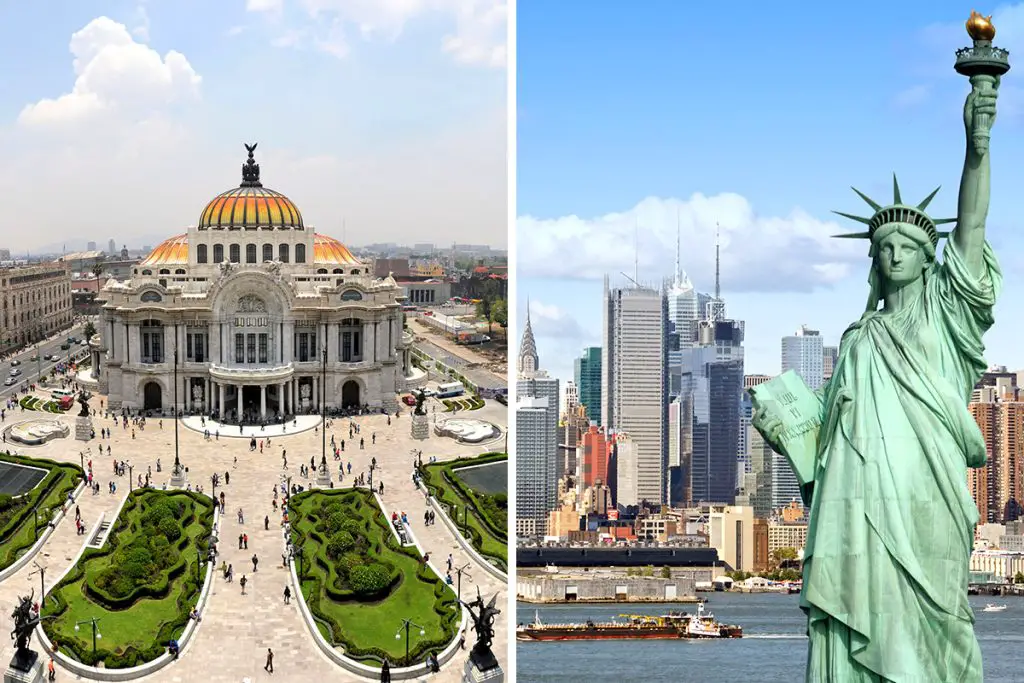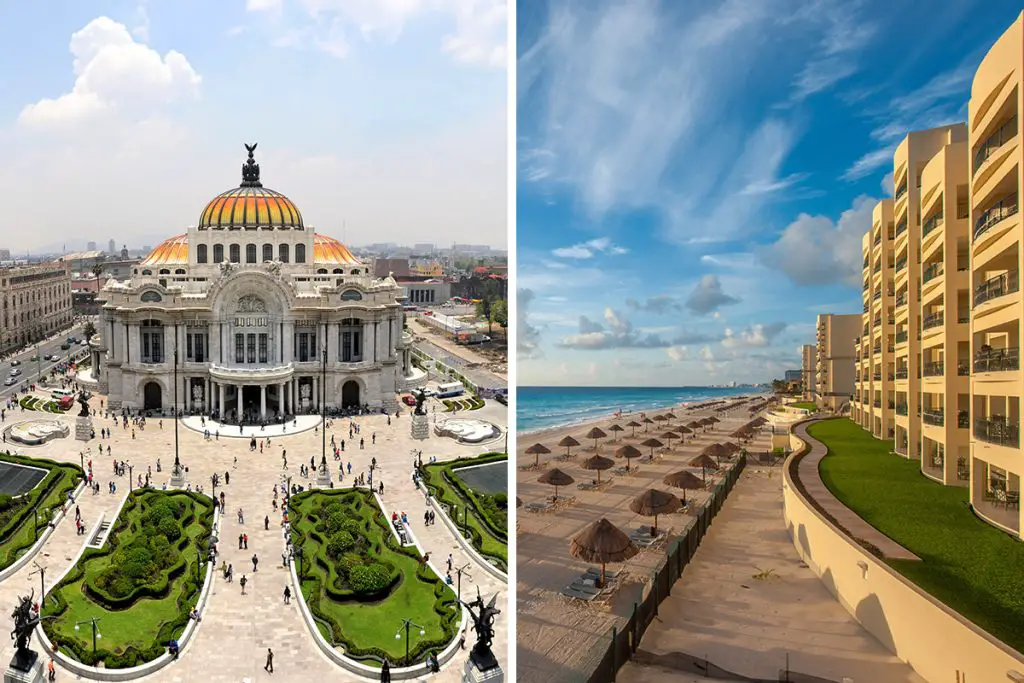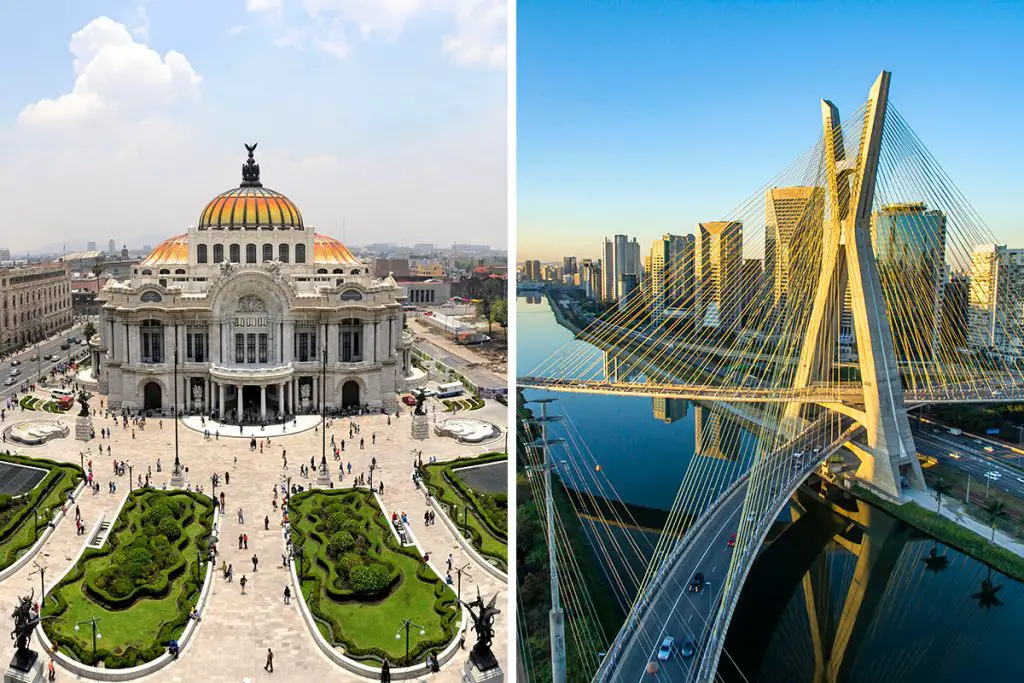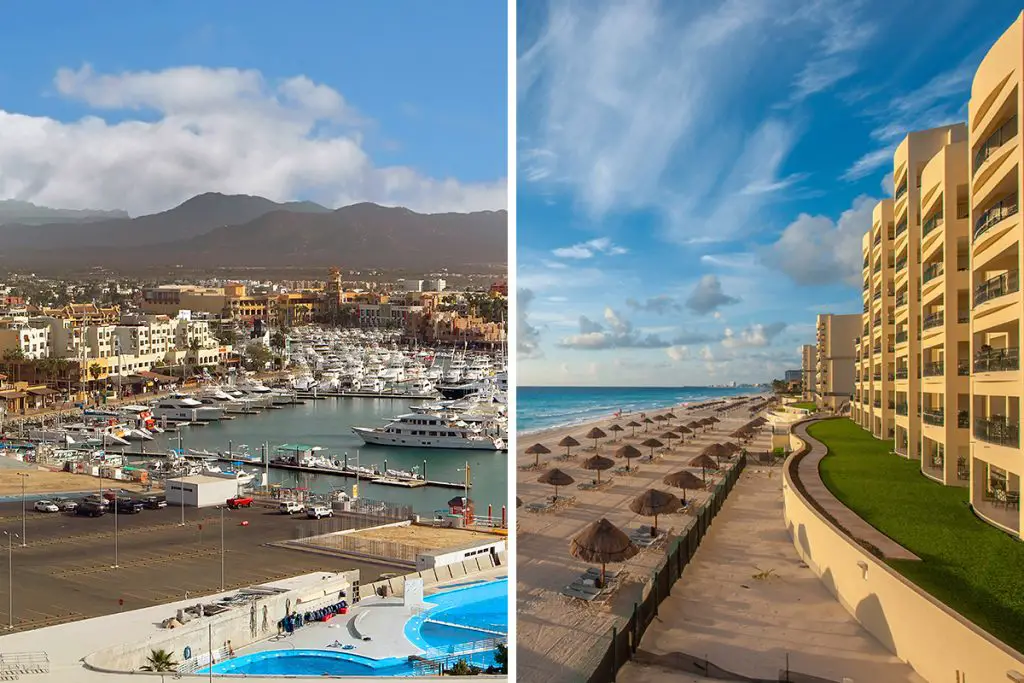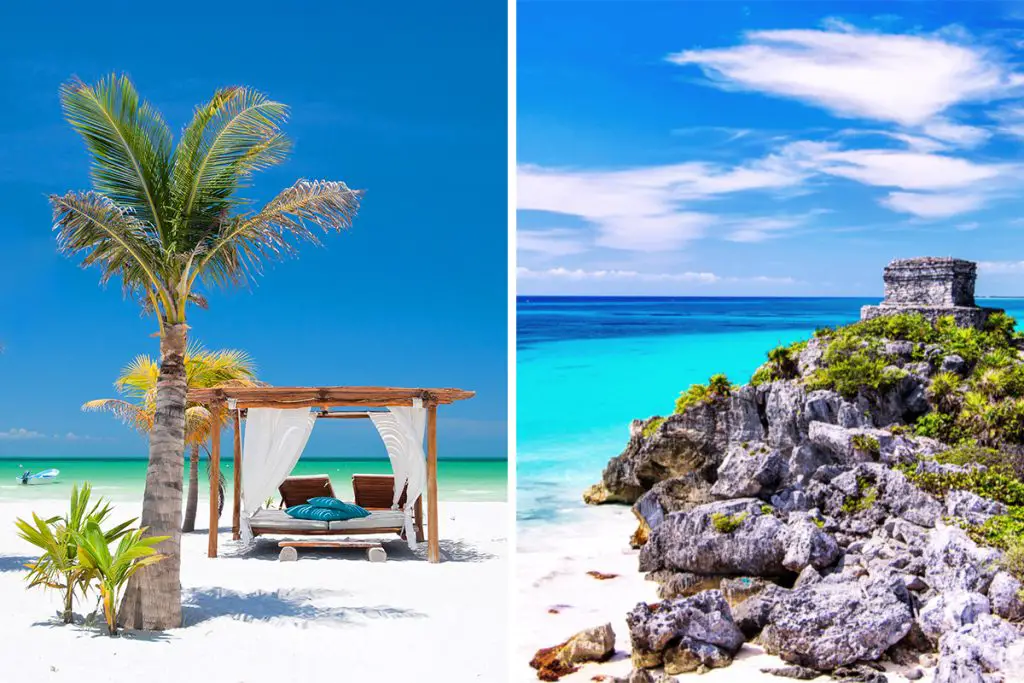Tulum is for the curious and adventurous, while Akumal is for the lazy, relaxed, and serene. These two distinct towns offer an even more varied view of the Riviera Maya. Sometimes you don’t have to choose between the two, you just have to do both. After all, they’re just 30 minutes away from each other.
Tulum
One of the most iconic destinations in all of Mexico, Tulum never goes out of style. The town is littered with draws that have garnered tons of international interest. Tulum has been seeing development in recent years. But Tulum still has kept its unique and rustic charm.
You can have the ruins and beaches by day and the Pueblo and its dining scene by night. You will surely have a little bit of everything here. On top of its old-town charm, you also have well-preserved and the most ecologically diverse nature surrounding you.
What Makes Tulum Unique?
Ancient Ruins
The Yucatan and most of the Riviera Maya are littered with ruins that date back before Mexico even became Mexico. It is no surprise that you’ll see one in Tulum. The ruins of Tulum are both idyllic and aesthetically perfect for postcards and travel articles. But what’s extra fascinating about this one is that its setting isn’t hidden in a dense forest.
The icon of Tulum sits on top of a cliff overlooking the playa below making it a spectacular sight, and a cool twist for a beach at the same time. The ruins of Tulum are perhaps one of the most defining draws of the town and the entire Riviera.
Tulum was once an important walled city used for trading due to its strategic location. The one you’ll see right overhead the Playa Ruinas is merely a watchtower and a small part of the complex. The entire site is also a place of worship, where religious celebrations and ceremonies are held. It is believed that Tulum holds the same value as Chichen Itza and Coba.
The ancient city was originally designed to be a stronghold on the coasts of the Mayan world. It has remarkable cliff sides offering protection from potential invasion. Due to these advantageous characteristics, the city holds great value for the Mayan people of the peninsula. Back in the day, several kinds of goods were traded here, such as cacao beans and cotton.
Consequently, the fame brought about by these wonders has lured massive throngs of visitors from all over the world. This makes Tulum more crowded than other towns in the Riviera Maya. Don’t expect the ruins and the neighboring beach below to be quiet and serene.
Here are some of the must-visit structures in the Tulum ruins:
El Castillo
The main pyramid of the Tulum ruins is perhaps its most imposing structure. Both functioning as a central structure and a lighthouse, El Castillo is incredibly fascinating. The pyramid was believed to house leaders in the city, and at the same time guide boats safe to shore.
However, tours to the pyramid only involve walking around the guided path surrounding it. Climbing and entering were once allowed. But it was eventually discontinued to preserve its beauty and integrity.
Temple of the Frescoes
This is the most well-preserved part of the ruins. The Temple of the Frescoes holds great value to the people of the ancient city, thanks to its social and religious importance. It may be a tiny building standing across the El Castillo, but it holds a mural inside that is still intact and in good condition. It was once an observatory studying the Sun’s movements through the skies.
House of the Halach Uinic
The House of the Halach Uinic used to be the residence of the city’s high priest. The Halach Uinic is the ancient Mayan supreme leader, the head of government of some sort. The Uinic’s house is well-preserved as you can still see a mural at the building’s entrance depicting a god.
Resident Wildlife
Despite the heavy foot traffic thanks to its fame, nature, and most especially the wildlife, still thrives outside the town’s paved roads. Once you step out of the town’s populated areas, you’ll find abundant and diverse flora and fauna that are well protected. Tulum is made even more special beyond its historical gems, and beaches.
One of Tulum’s special sites is the Si’an Kaan Biosphere, a protected area aimed at conserving and protecting a wide range of plant and animal species. Unknown to many, Tulum holds one of the most ecologically diverse spots in Mexico.
You can find marshes, tropical forests, and even mangroves inside the biosphere. However, what is perhaps the most fascinating part of the biosphere is its marine section. The section forms part of their resident Mesoamerican Barrier Reef, the second-largest in the world.
The biosphere protects over 300 different species of bird and land animals. You can expect to find different species of wild animals such as jaguars and spider monkeys. Tours around the biosphere are available in town, especially snorkeling where you can see a portion of the famous reef system.
Tulum Beaches
Tulum’s coastal stretch may not be as lengthy as Cancun or Playa del Carmen, but it certainly holds great beauty. One of the most photographed beaches in the world, Tulum easily takes a spot among Mexico’s most idyllic beaches. Soft white sand and continuous expanse define Tulum’s beaches, many having twists of their own.
Here are some of the most recommended spots:
Las Palmas
Know for its white-sand stretch and gentle, clear blue waters, Las Palmas is best for relaxing and lounging, doing nothing. You can also find a rocky area to the east creating a stark contrast to the beach’s characteristic soft sand overtones.
Las Palmas, despite being in Tulum — an extremely touristy town, is quiet and peaceful. The serenity you can enjoy here is the exact opposite of what most Tulum beaches have. Expect to see fewer tourists and vendors around. This is the ideal place to laze away for hours without distraction.
Playa Ruinas
Playa Ruinas is perhaps the most famous beach in Tulum, thanks to its characteristic ruins on top of the cliff. The ruins create a distinct sense of balance between nature and history. You can enjoy a dip or swim in the water while admiring the ruins that overlook the Caribbean.
Imagine watchtower ruins perched on the cliff and the turquoise-blue-water beach below for a sight. This genius combination is what helped put Tulum on the tourist map. Not many, if there are any, places in the world hold such a unique sight.
You can also head down to the Playa, right after your ruins tour. A perfect way to end a day of exploring and learning more about the peninsula’s magical history. However, expect to have to brave the crowd.
Playa Paraiso
Second to Playa Ruinas, Playa Paraiso is one of the most famous and most-visited places in town. Even though you haven’t been to Tulum or are just planning to go, chances are you’ve already seen photos of this picturesque beach. Playa Paraiso is one of the most photographed places in the country and has been constantly used to market its tourism.
Playa Paraiso’s charm is in how it chooses and manages to maintain its rustic and authentic charm. Thanks to its fame, many parts of Tulum have seen development, but not this beach. You can still see traditional Mexican beach facilities and features like palapas and beach vendors.
On top of its classic draws, the waters of Playa Paraiso allow for a perfect time on the beach. Thanks to its excellent clarity and gentle waves, you can enjoy swimming, snorkeling, and diving safely. However, equipment isn’t available, so you have to bring your own.
Recent Gastronomic Boom
Thanks to constant waves of international crowds, Tulum has seen culinary and cultural influences from all over the world. The local Mexican gastronomy is already the best as it is. But with the recent influx of foreign interest, international chefs and businesses have joined Tulum’s roster.
And the result? A beautiful burst of culinary diversity. The local gastronomy has upscaled yet remained faithful to its roots. With this genius blend, you can sample a variety of dishes from chic restaurants to street food stalls.
Explore the Pueblo area of Tulum and you’ll find an abundance of restaurants and cantinas. These places serve food from Europe, South America, to the Caribbean. Head to places such as the Posada Margherita, Hartwood, and Cetli. And if you want to try out authentic Mexican food right from the locals, head to the food-truck park and taste the best of the local dishes.
Kaan Luum Lagoon
Despite the caliber of Tulum’s ruins and beaches, it also has another draw that holds great value. Looking like paradise on earth, Tulum also boasts the fascinating Kaan Luum Lagoon located southwest of the Pueblo. Kaan Luum isn’t just a body of water, it also has a mysterious hole in the middle.
Kaan Luum’s most special feature is the strange giant blue hole in the middle of the lagoon, which has distinct dark blue water indicating its depth. What is even more fascinating is that it is in fact a cenote, a natural sinkhole that formed eons ago. The cenote has an estimated depth of 262 feet or 80 meters.
Around the rim of the hole, the lagoon has lovely mint-green water that is clear and swimmable. You can easily visit the lagoon as it is only a 30-minute drive away from the Pueblo area. Apart from good swimming and diving, the lagoon also has basic facilities for visiting guests.
Tulum Pueblo
Despite its obvious mass appeal, Tulum has kept its authentic and rustic charm which is most evident in its central town, called Tulum Pueblo. True to its Mexican roots, Tulum Pueblo’s streets and the overall scene are the best display of what a classic Riviera Maya community is.
Even after years of foreign influx and influences, which Tulum has warmly welcomed, the town has been perfectly balancing this mix. It has harmonized both its modern scene and its authentic spirit. This makes Tulum one of the most interesting towns you’ll ever visit in Mexico.
Around this central area, you can find a variety of shops, restaurants, and cafes founded and owned by locals. These businesses have boomed thanks to the constant rush of international visitors. Many of the town’s building has even kept their traditional and colonial designs as if giving you a sense of what Mexico is about.
Colonial and traditional facades may adorn the Pueblo. But just outside the paved roads, you can easily see the lush green backdrop of the Tulum jungle. One of its most underrated draws, Tulum’s jungle is a diverse area when it comes to flora and fauna and thus holds great value.
Thanks to this genius blend, and a respect for history, nature, and culture, Tulum is — in a way — valuable to all of Mexico. It is almost magical. Thus, the federal government has given it the designation of a “Pueblo Magico”, or Magic Town. Tulum is one of the latest additions to Mexico’s magical roster.
Akumal
Riviera Maya’s fame has earned well-known reception resulting in waves of tourist crowds each year, but not sleepy Akumal. The town prides itself in conserving nature and wildlife, while at the same time maintaining a quiet, simple, somehow upscale scene.
Akumal is best for those looking to have a real quiet and relaxed time in the ever-crowded Riviera Maya. Expect to enjoy your downtime, the beach, and even have a grand time with turtles here.
What Makes Akumal Unique?
Beaches
Thanks to its off-the-beaten-path scene and care for nature, Akumal’s beaches are spectacular. Many of its beaches are arguably some of the most serene you’ll ever visit in Mexico.
When you think of the Riviera Maya, most people will automatically go to Cancun, Playa del Carmen, or Tulum. But only a special few opt for the hidden gems in many of the world’s most-visited countries. This makes Akumal’s beaches extra charming and special for how sparse and least-visited it is. You can still feel the air of authenticity, and serenity on the beaches of Akumal.
But what makes the town’s beaches extra special is that in just a small area, Akumal boasts three coves. Each of these inlets has its distinct twists and characteristics. These three bays encompass three miles (4.8 km) of the Mexican Caribbean coast.
It features immaculate white sand, stunning blue water, and tropical vegetation. The three-mile coast proudly fronts the fabled Caribbean Sea and all its turquoise beauty.
Here are some of you can check out:
Akumal Bay
The town’s major beach is Akumal Bay. It’s also known as Akumal Beach, and it’s become a hidden gem along the coast. Thanks to its incomparable sand quality and the chance to snorkel with turtles right off the beach, Akumal Bay is certainly different.
The beach is just 500 meters (547 yd) from the major coastal highway, making it conveniently accessible. It is just far enough to make it feel like a world away.
Half Moon Bay
This is Akumal’s largest outer-lying reef, which captures the mild sea waves and protects Akumal Bay from the surf. Half Moon Bay boasts a good reef with excellent coral and snorkeling, as well as ideal swimming conditions and easier access to the sea.
Conveniently, Half Moon Bay is a 15-minute walk north along the coastal trail from Akumal Beach.
Place of the Turtles
Akumal, translated locally as “Place of the Turtles”, is the town’s three inlets or coves congregation area for hundreds of turtles every year. These lovely creatures lay their eggs during the summer months. So, if you visit Akumal around May through July, you will most certainly catch a spectacular site of them arriving.
If you want to take part in helping them and protecting their nests, you can do so by volunteering around town. You can help experienced volunteers while they teach you about turtles. These are valuable information and important instructions on how to help their species thrive.
Akumal used to let tourists swim or snorkel alongside turtles but unfortunately has been stopped. This is of course, for the protection of these gentle creatures.
Instead of snorkeling with them, you can give back and help them by looking after them, their nests, and their future hatchlings. Join the Turtle Night Watch activity that is available not just for residents, but also for tourists and visitors.
Keep your eyes alert as you scan the dunes for turtles. If you’re lucky enough to come across one, watch in awe as you see the turtle build the nest, deliver the eggs, cover it, and return to the sea. A truly rare opportunity.
After 60 days since the eggs are delivered, they will hatch, and out come dozens of baby turtles. There’s even the chance to see turtles emerge from their eggs and make their first crawl into the ocean. However, this is not guaranteed, but can definitely happen.
Laid-Back and Off the Beaten Path
Perhaps Akumal’s most defining charm has to be how laid-back and sparsely populated it is. Despite it being the first community built along the Riviera, Akumal can still feel like a world away, or rather a whole era away.
The town boasts its relaxed, slow, and authentic charm. Many areas in town were developed thanks to modern housing and resorts setting up shop. Akumal is the best escape you can have in an otherwise tourist-saturated region.
Many people have never even heard of Akumal, but those who have visited know how exceptional it is. Previous visitors rave about its breathtaking natural beauty and idyllic, calm lifestyle.
Formerly a coconut plantation, the town was built in 1958 by scuba divers who were attracted to the area’s abundance of underwater life. It boasts spectacular coral reefs, freshwater cenotes, caves and coves, and more than three kilometers (1.9 mi) of lovely bays.
For years, it was one of the Riviera Maya’s best-kept secrets, and it is still largely unknown internationally today. The few who know Akumal understand why it is unique and why it is one of Mexico’s Magic Towns.
Natural Treasures
You can expect to see an abundance of natural wonders sitting pretty. Just put together a sparse population, few developments, and a Riviera Maya address. Akumal is no stranger to Mother Nature’s incredible gifts, that’s why the town maintains them. A relatively low-profile name certainly does help.
Yal-Ku Lagoon
Often called a hidden paradise, Yal-Ku Lagoon is nothing short of enchanting. Imagine a stunning blue-water bay, with a mysterious hole in the middle. Yal-Ku is one of the most fascinating landmarks in all of Riviera Maya, despite its lesser-known name.
Yal-Ku Lagoon is a large freshwater lagoon connected to an ocean. The combination of fresh and saltwater provides a unique marine environment. This phenomenon attracts a diverse range of marine species of all kinds and sizes.
The water is also quite shallow, reaching a maximum depth of 13 feet (4 meters), making it a safe spot to snorkel even for beginners.
It’s also a terrific spot to unwind and enjoy the beautiful scenery, so bring a picnic and a drink and spend the day there.
However, this paradise is best for the nature-loving, outdoorsy types. Most especially those who love snorkeling. With the lagoon’s friendly conditions and perfect visibility, the best way to explore Yal-Ku is by snorkeling.
Aktun Chen Natural Park
Aktun Chen Natural Park is one of Akumal’s greatest pride. It is a feature spot that boasts 988 acres or 400 acres worth of lush vegetation and modern thrills, all in perfect balance. Where else can you find an underground cave, half-submerged in water, teeming with cenotes inside? Not to mention the park also boasts rides, tours, and all sorts of adventures.
It is the largest cave system in Quintana Roo, with three inner natural pool caverns. You can admire the beauty of hundreds of calcium carbonate formations formed over 5 million years by the slow seepage of water.
The Aktun Chen Natural pool has an estimated depth of 39 ft or 12 m. The pool features deep crystal blue water and is the only natural pool in Riviera Maya where swimming is allowed. It is located in one of the cave’s final portions.
Aktun Chen also gears towards the conservation of a slew of different animal and plant species. In a way, the place is yet another big eco-tourism spot in the Riviera. Aktun Chen is one of the must-visit entries in Akumal because it helps raise awareness and at the same time offers fun and excitement.
Which Is Better – Akumal or Tulum?
When deciding which town is better to stay in, Akumal and Tulum have big differences that may appeal to different kinds of travelers. It’s best to decide what experience you want to have on this side of Mexico.
Tulum has a little bit of everything you’ll be looking for in a small and simple town. The town boasts history, culture, and nature. Expect to see a perfect blend of classic Mexican charms, from adventures and food trips to entertainment. Plus, Tulum also has decent nightlife. But on top of its classic tourist draws, Tulum has ruins that have consistently lured countless people every year.
Akumal is still a great place to stay and explore. The small town has great beaches that aren’t as crowded as Tulum’s, giving you a sense of exclusivity. Akumal also has a great natural scene providing protection and conservation to both flora and fauna. If you’re looking for a less touristy vibe, Akumal is a great place to escape to.
FAQ
Staying in Akumal vs. Tulum
When it comes to accommodations, Tulum obviously offers more options than Akumal. Additionally, Tulum has a wider range of stays for different types of travelers, whether you’re a backpacker or an all-out vacationer. The town is famous for how it welcomes thousands of visitors every year, so you can expect to see a well-developed hospitality industry.
Is Akumal in Tulum?
Akumal and Tulum are two separate towns in the state of Quintana Roo, straddling the Riviera Maya. Akumal is located between Playa del Carmen and Tulum, with Tulum being the southernmost town on the Riviera. However, you can take a bus, or a rental car between them and would only take around 30 minutes.
How Far Is Tulum From Akumal?
Tulum is approximately 13 miles or 26 km from Akumal, directly. Should you decide to take the long road, the road distance is around 17 miles, or 27.2 km, and would typically take 30 minutes to drive.
How to Get From Akumal to Tulum
You have three main options to travel between them: by car, taxi, or bus. Depending on certain traffic factors, a typical journey between them would only take around 30 minutes.

